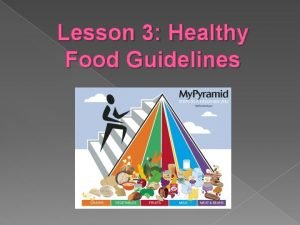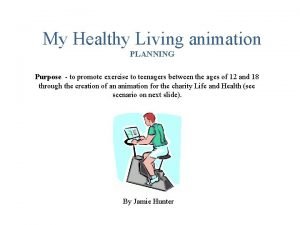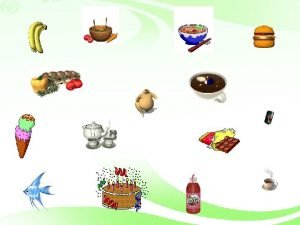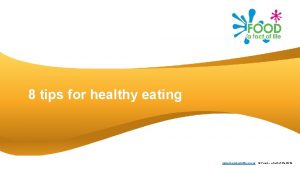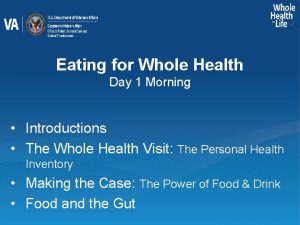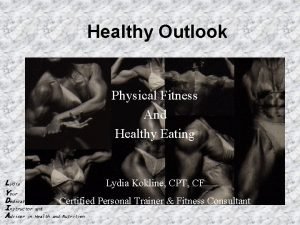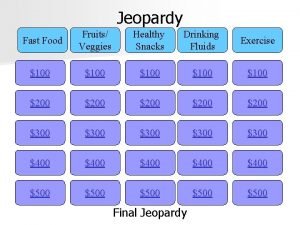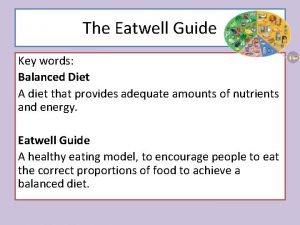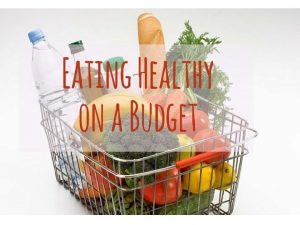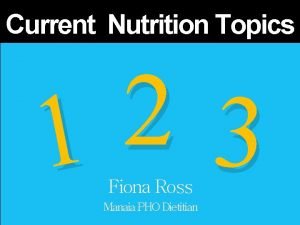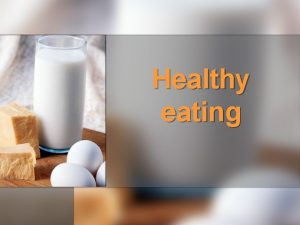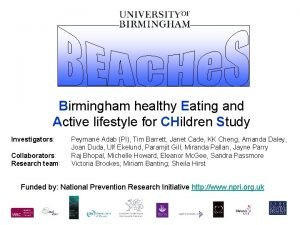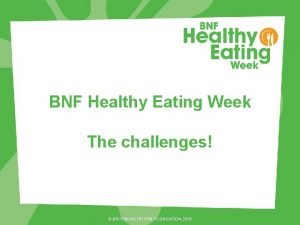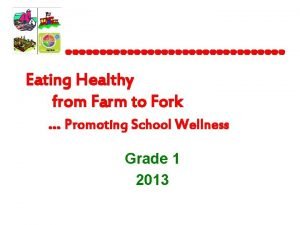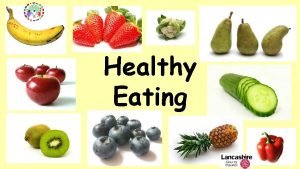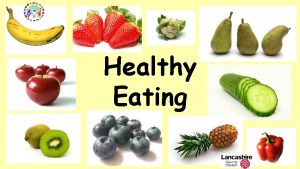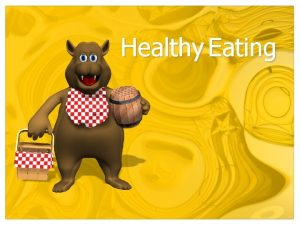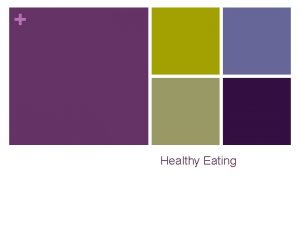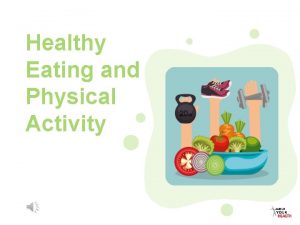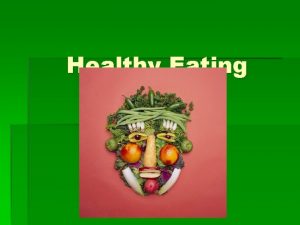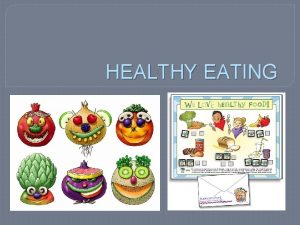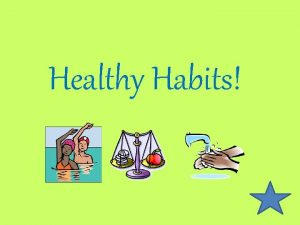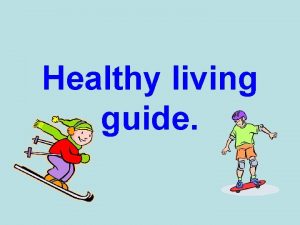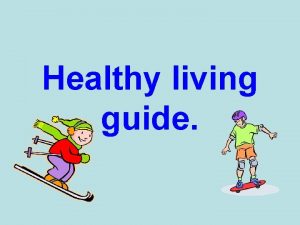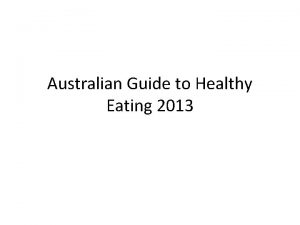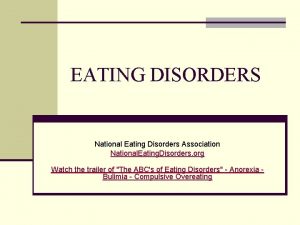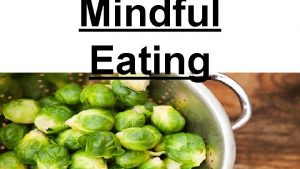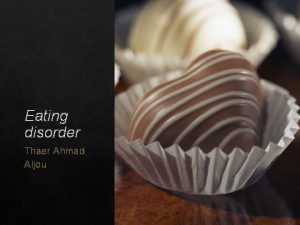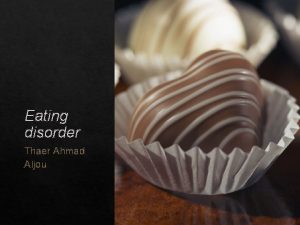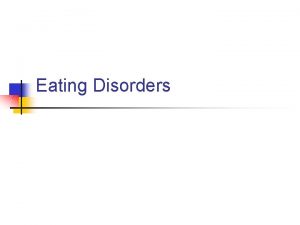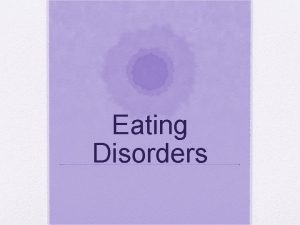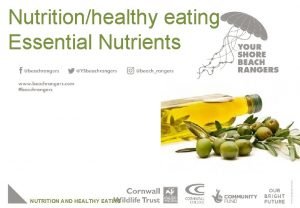AUSTRALIAN GUIDE TO HEALTHY EATING The Australian Guide























- Slides: 23

AUSTRALIAN GUIDE TO HEALTHY EATING

The Australian Guide to Healthy Eating provides practical advice to help people choose a healthy diet which will help to reduce the incidence of diet related diseases in Australia. The guide provides information about the amounts and kinds of food that you need to eat each day to get enough nutrients essential for good health and well-being.

THE AUSTRALIAN GUIDE TO HEALTHY EATING. The model represents a plate on a table. Why do you think this has been done?

THE FIVE FOOD GROUPS • Breads, cereals rice, pasta noodles • Vegetables, legumes • Fruit • Milk, yoghurt, cheese • Meat, fish, poultry, eggs, nuts, legumes These foods provide the important nutrients the body needs. Extra foods that may be eaten sometimes or in small amounts.

VARIETY Why is variety so important? Eating a wide variety of foods has a very positive effect on health. Variety amount the groups If you eat from each of the five groups in the amounts recommended, it is likely that your diet will contain all the nutrients that you need. Variety within the groups Different foods provide more of some nutrients than others. If you eat a variety of foods from within each groups, it likely that you will get all the nutrients provided by the foods in that group.

Foods in this group come from grains like wheat, oats, rice, rye, barley, millet and corn. BREAD, CEREALS, RICE, PASTA, NOODLES Nutrients provided by the foods in this group include carbohydrates, protein, fibre and a range of nutrients and minerals including folate, thiamin, riboflavin, niacin, and iron. Wholemeal or wholegrain varieties provide more fibre, vitamins and minerals. What is a sample serve? A serve is: 2 slices of bread, 1 cup of cooked rice, pasta, noodles 1 cup porridge, 1 & 1/3 cup breakfast cereal flakes Or ½ cup muesli How much bread, cereals, rice, pasta, noodles is needed every day? The range for 12 -18 years is 4 – 7 serves

VEGETABLES, LEGUMES Vegetables come from many different parts of plants. Some vegetables like tomatoes and pumpkin are the fruit of the plant, but are included in this group because they are used as a vegetable. Legumes are the seeds from peas and, beans- dried peas, beans , lentils and chick peas. Vegetables and legumes are a good source of vitamins – A and C, minerals – folate, dietary fibre, and carbohydrate. What is a sample serve? A sample serve is: 75 g or ½ cup cooked vegetables, 75 g or ½ cup dried beans, peas, lentils 1 cup salad vegetables or 1 potato How much vegetables and legumes are needed every day? The range for 12 -18 years is 5 – 9 serves.

FRUIT Fruit is a good source of Vitamins including C and folate. It also Provides carbohydrates, particularly sugars and fibre, especially in the edible skins. Juices belong to this group, but they have a much lower fibre content than fresh fruit. What is a sample serve? A serve of fruit is: 1 medium piece eg. Apple, banana, orange, pear. 2 small pieces, eg apricot, kiwi fruit 1 cup dried pieces or canned fruit ½ cup juice Dried fruit eg. 4 dried apricot halves 1 ½tablespoons sultanas How much fruit is needed every day? The range for 12 -18 years is 3 - 4 serves.

MILK, YOGHURT, CHEESE Milk, yoghurt and firm cheeses are three important foods in this group. Choices of milk, yoghurt, and cheese can be made on the basis of fat content and flavourings used. For most people over 5 years of age, choices of low fat milk, yoghurt and cheese is best. The foods in this group are an excellent source of calcium, good source of protein, riboflavin, and vitamin B 12. What is a sample serve? A serve of milk, yoghurt, cheese is: 250 ml milk, ½cup evaporated milk, 40 g ( 2 slices) cheese, 200 g (1 small carton) yoghurt 150 ml (one cup) custard How much milk, yoghurt, cheese is needed every day? The range for 12 -18 years is 3 – 5 serves or approx. 750 ml to 1 litre.

MEAT, FISH, POULTRY, EGGS, LEGUMES This group consists of all. NUTS kinds of&meat, poultry, fish, eggs, nuts and nut pastes Such as peanut butter, legumes and some seeds such as sunflower and sesame seeds. Foods in this group are a good source of protein, iron, niacin, and vitamin B 12. Red meats are a good source of iron and zinc. The iron in animal foods is more easily absorbed by the body than the iron in plant foods. What is a sample serve? A serve is: 65 – 100 g cooked meat , chicken, eg ½ cup lean mince, 2 small chops or 2 slices roast meat. ½ cup cooked dried beans, lentils, chick peas, split peas or canned beans 80 – 120 g cooked fish fillet 2 small eggs 1/3 cup peanuts or almond or ¼ cup sunflower or sesame seeds How much meat, fish, poultry, eggs, nuts legumes are needed every day? The range for 12 -18 years is 1 -2 serves per day

EXTRA FOODS Some foods do not fit into the five food groups. They are not necessary to provide the nutrients the body needs and some contain too much fat, salt and sugars. However they can add to the enjoyment of eating a healthy diet. Alcoholic drinks are not essential to provide the nutrients the body needs. They should be only consumed sometimes, in small amounts or not at all. Alcohol is not recommended for children, pregnant or breastfeeding women. What is a sample serve? A sample serve is: 1 doughnut, 4 plain sweet biscuits, 1 slice plain cake, ½ small bar chocolate, 200 mls wine, 1 can soft drink, 1/3 meat pie, 12 (60 g) hot chips, 1 ½ scoops ice cream. How much extra food is needed every day? The range for 12 – 18 years is 1 -3 serves per day.

DRINK PLENTY OF WATER For good health, adults need to drink 8 glasses of water every day. They need more during physical activity and in hot weather. All fluids, other than alcoholic drinks, contribute to this requirement. Water is the best drink to quench your thirst.



HOW TO MAKE BETTER CHOICES What can we swap the following items for? Cooked breakfast (eggs, bacon, sausages and white toast) Fruit and cereal, high in grains and fibre Filled croissant Plain bagel or raisin toast Glass of fruit juice Piece of fruit and a glass of water Ham and cheese toasted sandwich Multigrain toasted sandwich with lean ham and cheese

HOW TO MAKE BETTER CHOICES What can we swap the following items for? Handful of lollies Handful of berries Large coffee Small coffee Large portion of milk chocolate Small portion of dark chocolate Spread of margarine Small spread of avocado

HOW TO MAKE BETTER CHOICES What can we swap the following items for? Cream Fried eggs Low-fat yoghurt Poached or boiled eggs Fruit straps Piece of fruit Spread of margarine Small spread of avocado

CASE STUDY - JESSICA Breakfast: Jessica is a 17 -year-old Year 11 ‘Up and Go’ student. She plays netball in the Morning snack: state and local teams four to five times a week and trains twice a week. She is busy studying for her VCE and often stays up late in order to Krispy Kreme doughnut Banana Lunch: 1 cheese and salad sandwich – carrots, lettuce, cucumber, sliced beetroot, sliced ham – using wholemeal bread Coffee scroll complete her homework after she Orange Juice finishes netball training. Afternoon snack: Packet of 2 minute noodles Below is a sample of Jessica’s food Orange Juice intake for a typical weekday. Dinner: Lasagne Garden Salad (lettuce, cucumber, carrot, oil-based salad dressing).

1) Evaluate the nutritional adequacy of this one-day food intake using the Australian Guide to Healthy Eating (10 marks). • What I am looking for! • • Reference is made to the case study Reference is made to the 5 food groups, water intake and extra foods Reference is made to the number of servings she has and the number of servings needed Reference is made to the nutritional quality of the foods

Jessica is a very active student who appears to consume a variety of foods throughout her day. She is able to reach the required 5 -9 serves of vegetables through her salad sandwich at lunch and the Garden Salad at dinner. The use of wholemeal bread on her sandwich improves the nutritional content of her meal to provide more vitamins, minerals and fibre. This along with the consumption of lasagne and noodles as a snack brings her close to the recommended serves of 4 -7 per day. The only fruit Jessica eats is a banana in the morning, although she consumes two cups of orange juice throughout the day, it does not contain the same fibre and vitamins that a piece of fruit would. She should be aiming to get at least 3 serves a day of fruit. Calcium is important for the growth of Jessica’s bones and she should be having 3 -5 serves a day of dairy foods. However, in her sample food intake she only has a piece of cheese on her sandwich and an ‘Up-and-Go’. During the day she consumes a piece of ham on her sandwich and most likely mince meat in the lasagne. Through these items she is able to reach the required 1 -2 serves of meat. Jessica does also consume some extra foods in the coffee scroll and Krispy Kreme doughnut. These foods are okay to eat 1 -3 times per day, and as she is so active she will most likely burn off any unwanted calories. Jessica does not drink any water during the day. She should aim to drink 8 glasses and swap the orange juice for water and eat the real fruit instead.

2) Make suggestions on how Jessica could improve her food intake in order to meet her daily nutritional requirements. Use the table below to organise your response (6 marks). Food Intake Breakfast Snack Lunch Snack Dinner Snack Major nutrients provided by the food or drink Suggestions for improvement

2) Make suggestions on how Jessica could improve her food intake in order to meet her daily nutritional requirements. Use the table below to organise your response (6 marks) Food Intake Major nutrients provided by the food or drink Suggestions for improvement Breakfast Up and Go Wholegrain Cereal with low-fat milk and strawberries Glass of water Snack Krispy Kreme doughnut Banana 200 g low-fat yoghurt Glass of water Lunch 1 cheese and salad sandwich – carrots, lettuce, cucumber, sliced beetroot, sliced ham – using wholemeal bread Coffee scroll Orange Juice 1 cheese and salad sandwich – carrots, lettuce, cucumber, sliced beetroot, sliced ham – using wholemeal bread Handful of almonds Glass of water Snack Packet of 2 minute noodles Orange Juice Small bowl of unbuttered, unsalted popcorn 1 -2 pieces of dark chocolate Orange Glass of water Dinner Lasagne Garden Salad (lettuce, cucumber, carrot, oil-based salad dressing). Lasagne (made with lean-mince and low-fat cheese) Garden Salad (lettuce, cucumber, carrot, oil-based salad dressing). 2 glasses of water Snack Nothing Fruit Salad – tinned in natural juice with low-fat yoghurt Glass of water

3) What factors could be influencing Jessica’s food selections? (4 marks) • Food availability • Food preferences • Family • Social considerations • Cost • Convenience • Mood • Allergies or food intolerances
 Interactive guide to healthy eating and active living
Interactive guide to healthy eating and active living Esol british council
Esol british council Healthy eating animation
Healthy eating animation Energy giving food definition
Energy giving food definition Foodfactoflife
Foodfactoflife How eating healthy affects your body
How eating healthy affects your body The healthy eating project lydia
The healthy eating project lydia Jeopardy fruits and vegetables
Jeopardy fruits and vegetables The eatwell challenge
The eatwell challenge The three p's for eating healthy on a budget
The three p's for eating healthy on a budget Healthy eating title
Healthy eating title Healthy sentences
Healthy sentences Healthy eating questionnaire for schools
Healthy eating questionnaire for schools Healthy eating birmingham
Healthy eating birmingham When is healthy eating week 2018
When is healthy eating week 2018 Eating healthy from farm to fork
Eating healthy from farm to fork Esol nexus past simple
Esol nexus past simple Healthy community poster
Healthy community poster Healthy nurse healthy nation
Healthy nurse healthy nation Journal on healthy food healthy mind
Journal on healthy food healthy mind Healthy soil healthy life poster ideas
Healthy soil healthy life poster ideas Chapter 11
Chapter 11 độ dài liên kết
độ dài liên kết Chó sói
Chó sói
